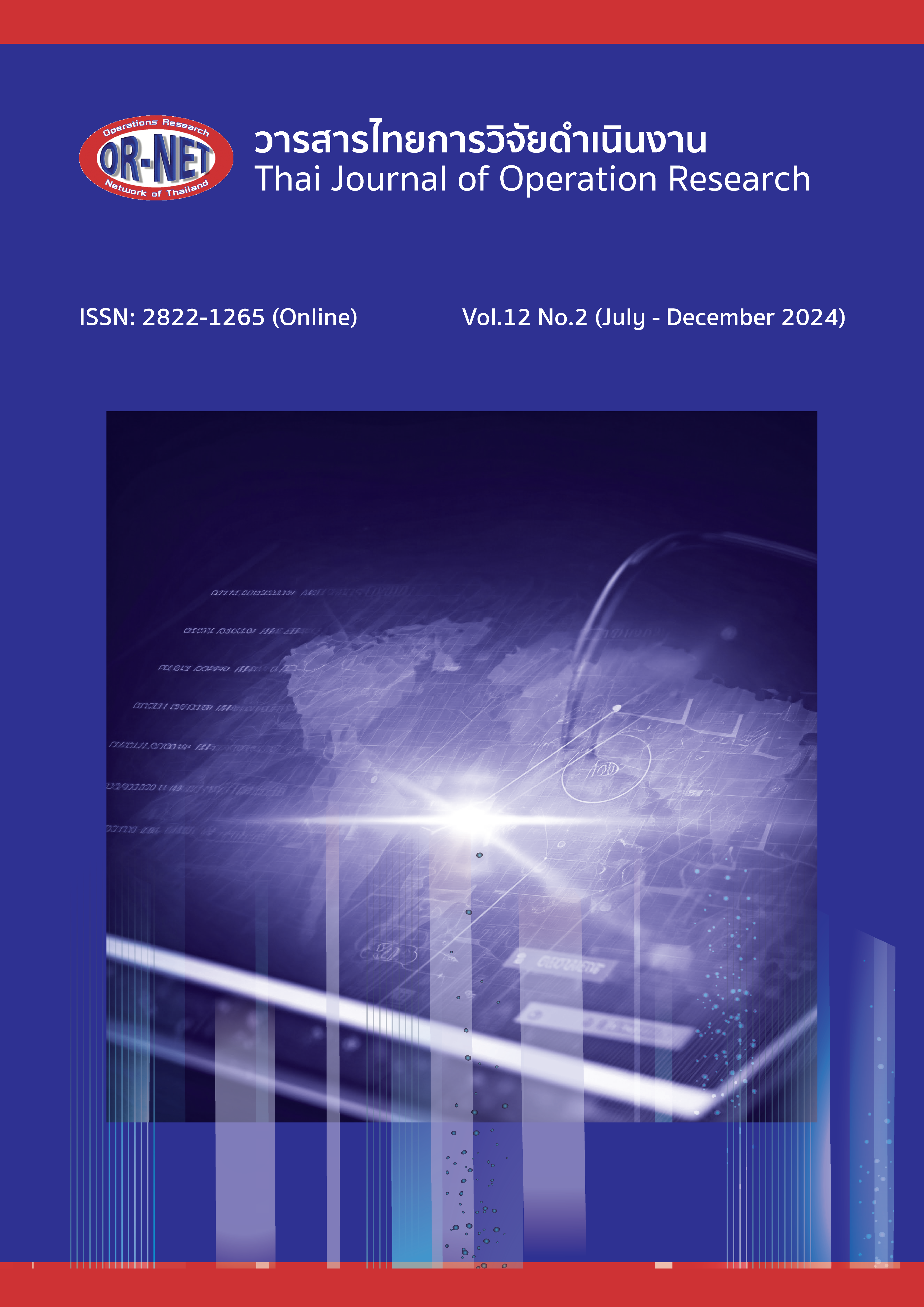Multiple Objectives Optimization: from development in the past to future of applications
Keywords:
multiple objective optimization, operations research, decision-makingAbstract
Multiple objective optimization (MOO) is critical in operations research and decision-making. It has crucial benefits for industrial work regarding efficient resource management, such as raw materials, labor, machinery, time, finances, and production methods. This article will present the concept of the model. and the process of multiple objective optimization. The objective is to enable readers to understand techniques for using multiple objective optimization theory. The article reviews the literature and gives examples of case studies using mathematical models to help with multiple objective decision-making in many industrial sectors, such as resource planning process improvement and transportation management. The knowledge gained from this article is valuable and helps the readers apply the knowledge of multiple objective optimization to other types of problems.
References
S. C. Cerda-Flores, A. A. Rojas-Punzo and F. Nápoles-Rivera, “Applications of multi-objective optimization to industrial processes: a literature review,” Processes., vol. 10, no. 1, pp. 133, 2022.
P. R. Thie and G. E. Keough, An Introduction to Linear Programming and Game Theory, 3rd ed., New Jersey: Wiley, 2008.
A. Kengpol, Multiple Criteria Decision Making Volume 1, Bangkok: King Mongkut's University of Technology North Bangkok, 2011.
M. S. Uddin, M. Miah, M. A. Khan and A. AlArjani, “Goal programming tactic for uncertain multi-objective transportation problem using fuzzy linear membership function,” Alexandria Engineering Journal., vol. 60, no. 2, pp. 2525-2533, 2021.
T. Y. Chen, “A circular intuitionistic fuzzy assignment model with a parameterized scoring rule for multiple criteria assessment methodology,” Advanced Engineering Informatics., vol. 61, 2024.
A. Baykasoğlu and K. Subulan, “An analysis of fully fuzzy linear programming with fuzzy decision variables through logistics network design problem,” Knowledge-Based Systems., vol. 90, no. c, pp. 165-184, 2015.
I. A. Baky, “Solving multi-level multi-objective linear programming problems through fuzzy goal programming approach,” Applied Mathematical Modelling., vol. 34, no. 9, pp. 2377-2387, 2010.
N. Kalaivani and E. M. Visalakshidevi, “A generalized novel approach to transportation problem using multi partite-graph method,” Measurement: Sensors., vol. 33, 2024.
P. Adulbhan and M. T. Tabucanon, “Bicriterion linear programming,” Computers & Operations Research., vol. 4, no. 2, pp. 147-153, 1977.
A. A. Karim, S. G. Partiwi and A. Sudiarno, “Designing Key Performance Indicators (KPI) with macro ergonomics approach,” in International Mechanical and Industrial Engineering Conference 2018 (IMIEC 2018), Malang, Indonesia, 2018.
K. Midor, E. Sujová, H. Cierna, D. Zarebinska and W. Kaniak, “Key performance indicators (KPIs) as a tool to improve product quality,” New Trends in Production Engineering., vol. 3, no. 1, pp. 347-354, 2020.
A. Cosma, R. Conte, V. Solina and G. Ambrogio, “Design of KPIs for evaluating the environmental impact of warehouse operations: a case study,” Procedia Computer Science., vol. 232, pp. 2701-2708, 2024.
A. Kengpol and C. Chanchittakarn, “The influence of vertical centrifugal casting on nickel aluminum bronze alloy for using in the Royal Thai Navy,” Applied Science and Engineering Progress., vol. 14, no. 3, pp. 503-510, 2021.
A. Konak, D. W. Coit and Alice E. Smith, “Multi-objective optimization using genetic algorithms: a tutorial,” Reliability Engineering & System Safety., vol. 91, no. 9, pp. 992-1007. 2006.
J. A. Sharp and D. H. R. Price, “Industry modelling,” Omega., vol. 10, no. 3, pp. 237-247, 1982.
M. Hizam-Hanafiah, M. A. Soomro and N. L. Abdullah, “Industry 4.0 readiness models: a systematic literature review of model dimensions," Information., vol. 11, no. 7, p. 364, 2020.
S. Schumacher, B. Pokorni, H. Himmelstoß and T. Bauernhansl, “Conceptualization of a framework for the design of production systems and industrial workplaces,” Procedia CIRP., vol.91, pp.176-181, 2020.
A. Kumar, P. Singh and Y. Kacher, “Neutrosophic hyperbolic programming strategy for uncertain multi-objective transportation problem,” Applied Soft Computing., vol. 149, 2023.
A. Kengpol and A. Klaiklueng, “Design of machine learning for limes classification based upon Thai Agricultural Standard No. TAS 27-2017,” Applied Science and Engineering Progress., vol. 18, no. 1, 2025.
M. T. Tabucanon, “Multiple-criteria decision-making: balancing a variety of needs and goals,” Engineering Costs and Production Economics., vol. 10, pp. 85-87, 1986.
M. T. Tabucanon, Multiple Criteria Decision Making in Industry, Amsterdam, Netherlands: Elsevier, 1988.
W. Punyota, A. Kengpol and P. Rungsaksangmanee, “The Application of An Analytic Network Process to Select Vegetarian Food for Chronic Disease Patients,” in Research, and Innovation Congress (RI²C 2022), Bangkok (Online), Thailand, 2022.
A. Duangsuphasin, A. Kengpol and P. Rungsaksangmanee, “The Design of a Deep Learning Model to Classify Passion Fruit” for the Ageing Society,” in Research, and Innovation Congress (RI²C 2022), Bangkok (Online), Thailand, 2022.
N. Delgarm, B. Sajadi, F. Kowsary and S. Delgarm, “Multi-objective optimization of the building energy performance: a simulation-based approach by means of particle swarm optimization (PSO),” Applied Energy., vol.170, pp. 293-303, 2016.
B. İzgi, “Machine learning-driven multi-objective optimization of fin geometry for enhanced charging and discharging performance in LTES system,” Journal of Energy Storage., vol. 98, 2024.
A. Kengpol and K. Elfvengren, “Avoiding covid-19 using a 3D digital mock up and augmented reality with Cobot in digital factory,” Applied Science and Engineering Progress., vol. 15, no. 3, 2022.
Downloads
Published
How to Cite
Issue
Section
License

This work is licensed under a Creative Commons Attribution-NonCommercial-NoDerivatives 4.0 International License.




